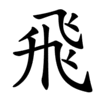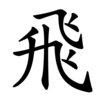飛
See also: 飞
Translingual
| Stroke order | |||
|---|---|---|---|

| |||
| Stroke order (Japan) | |||
|---|---|---|---|

| |||
Han character
飛 (Kangxi radical 183, 飛+0, 9 strokes, cangjie input 弓人竹廿人 (NOHTO), four-corner 12413, composition ⿻𠃧⿰亻丨)
- Kangxi radical #183, ⾶.
Derived characters
Related characters
References
- Kangxi Dictionary: page 1415, character 14
- Dai Kanwa Jiten: character 44000
- Dae Jaweon: page 1938, character 1
- Hanyu Da Zidian (first edition): volume 7, page 4513, character 1
- Unihan data for U+98DB
Chinese
| trad. | 飛 | |
|---|---|---|
| simp. | 飞 | |
Glyph origin
| Historical forms of the character 飛 | |||
|---|---|---|---|
| Shang | Warring States | Shuowen Jiezi (compiled in Han) | Liushutong (compiled in Ming) |
| Oracle bone script | Chu slip and silk script | Small seal script | Transcribed ancient scripts |

|

|

|

|
Pictogram (象形) : looks like a bird flying upwards.
In modern form, resembles a tasseled 升 (shēng).
Etymology
Area word:
- Proto-Sino-Tibetan *bjar ~ *p(i/u)r (“to fly”) > Tibetan འཕུར ('phur),
- Proto-Mon-Khmer *par (“to fly”) > Old Mon ပဝ် (pɔ); Proto-Vietic *pər (“to fly”) (> Vietnamese bay).
Cognate with 翂 (OC *pɯn, “appearance of birds flying slowly”), 𦐈 (“fly, soar”), 奮 (OC *pɯns, “spread wings and fly”).
Cantonese sense "fare" is from English fare.
Pronunciation
- Mandarin
- (Standard)
- (Chengdu, Sichuanese Pinyin): fei1
- (Dungan, Cyrillic and Wiktionary): фи (fi, I)
- Cantonese (Jyutping): fei1
- Gan (Wiktionary): fi1
- Hakka
- Jin (Wiktionary): fei1
- Eastern Min (BUC): buŏi / hĭ
- Southern Min
- Wu (Shanghai, Wugniu): 1fi
- Xiang (Changsha, Wiktionary): fei1
- Mandarin
- (Standard Chinese)+
- Hanyu Pinyin:
- Zhuyin: ㄈㄟ
- Tongyong Pinyin: fei
- Wade–Giles: fei1
- Yale: fēi
- Gwoyeu Romatzyh: fei
- Palladius: фэй (fɛj)
- Sinological IPA (key): /feɪ̯⁵⁵/
- (Chengdu)
- Sichuanese Pinyin: fei1
- Scuanxua Ladinxua Xin Wenz: fei
- Sinological IPA (key): /fei⁵⁵/
- (Dungan)
- Cyrillic and Wiktionary: фи (fi, I)
- Sinological IPA (key): /fi²⁴/
- (Note: Dungan pronunciation is currently experimental and may be inaccurate.)
- (Standard Chinese)+
- Cantonese
- (Standard Cantonese, Guangzhou–Hong Kong)
- Jyutping: fei1
- Yale: fēi
- Cantonese Pinyin: fei1
- Guangdong Romanization: féi1
- Sinological IPA (key): /fei̯⁵⁵/
- (Standard Cantonese, Guangzhou–Hong Kong)
- Gan
- (Nanchang)
- Wiktionary: fi1
- Sinological IPA (key): /fɨi⁴²/
- (Nanchang)
- Hakka
- (Sixian, incl. Miaoli and Meinong)
- Pha̍k-fa-sṳ: pî / fî
- Hakka Romanization System: bi´ / fi´
- Hagfa Pinyim: bi1 / fi1
- Sinological IPA: /pi²⁴/, /fi²⁴/
- (Meixian)
- (Sixian, incl. Miaoli and Meinong)
Note:
- pî/bi1 - vernacular;
- fî/fi1 - literary.
- Jin
- (Taiyuan)+
- Wiktionary: fei1
- Sinological IPA (old-style): /fei¹¹/
- (Taiyuan)+
- Eastern Min
- (Fuzhou)
- Bàng-uâ-cê: buŏi / hĭ
- Sinological IPA (key): /pui⁵⁵/, /hi⁵⁵/
- (Fuzhou)
Note:
- buŏi - colloquial;
- hĭ - literary.
- Southern Min
- (Hokkien: Xiamen, Taipei, Magong, Hsinchu, Philippines)
- Pe̍h-ōe-jī: pe
- Tâi-lô: pe
- Phofsit Daibuun: pef
- IPA (Xiamen, Taipei): /pe⁴⁴/
- IPA (Philippines): /pe³³/
- (Hokkien: Quanzhou, Lukang, Sanxia, Kinmen, Hsinchu)
- (Hokkien: Zhangzhou, Kaohsiung, Tainan, Yilan, Taichung)
- Pe̍h-ōe-jī: poe
- Tâi-lô: pue
- Phofsit Daibuun: poef
- IPA (Zhangzhou, Kaohsiung, Tainan, Yilan): /pue⁴⁴/
- (Hokkien: Xiamen, Quanzhou, Zhangzhou, General Taiwanese)
- (Hokkien: Taipei, Kaohsiung, Hsinchu, Taichung, Magong)
- Pe̍h-ōe-jī: hoe
- Tâi-lô: hue
- Phofsit Daibuun: hoef
- IPA (Taipei, Kaohsiung): /hue⁴⁴/
- (Hokkien: Xiamen, Taipei, Magong, Hsinchu, Philippines)
- (Teochew)
- Peng'im: buê1 / hui1
- Pe̍h-ōe-jī-like: pue / hui
- Sinological IPA (key): /pue³³/, /hui³³/
Note:
- buê1 - colloquial;
- hui1 - literary.
- Middle Chinese: pj+j
- Old Chinese
- (Baxter–Sagart): /*Cə.pə[r]/
- (Zhengzhang): /*pɯl/
Definitions
- to fly
- to move in the sky; to hover, to flutter, to dart
- to disappear
- fast; rapid; swiftly
- very; extremely
- groundless; unfounded
- unexpected; accidental
- flying; suspending
- (Cantonese) to remove
- (Cantonese) to skip; to disregard, miss or omit part of a continuation
- (Cantonese) ticket; fare (Classifier: 張/张 c)
- (loanword) femto- (SI unit prefix)
- (Xiamen and Zhangzhou Hokkien) to fizzle out; to fail; to fall through
Compounds
Lua error in Module:zh/templates at line 32: This template has been deprecated. Please use Template:col3 instead.
Synonyms
- (remove): 除 (chú), 去除 (qùchú), 移除 (yíchú)
- (skip): 跳 (tiào), 略過/略过 (lüèguò)
- (ticket): 券 (quàn), 票 (piào); (Min Nan) 單/单 (dān)
See also
| SI prefix | ||
|---|---|---|
| Last | Next | |
| 皮 (pí) | 飛 | 阿 |
Descendants
Japanese
Kanji
飛
Readings
- Go-on: ひ (hi, Jōyō)
- Kan-on: ひ (hi, Jōyō)
- Kun: とぶ (tobu, 飛ぶ, Jōyō); とばす (tobasu, 飛ばす, Jōyō)
- Nanori: あす (asu); とび (tobi); たか (taka)
Noun
- Abbreviation of 飛車 (hisha).
Compounds
- 飛行 (hikō): aviation
- 飛行機 (hikōki): airplane, aircraft
- 飛行場 (hikōjō): airfield, airport
- 飛来 (hirai): come flying
- 飛鳥 (hichō): flying bird
- 雄飛 (yūhi): launching out
- 飛球 (hikyū): fly ball
- 犠飛 (gihi): sacrifice fly
- 飛躍 (hiyaku): leaping, activity
- 突飛 (toppi): erratic, offbeat
- 飛び上がる (tobiagaru): spring, jump up
- 飛び込む (tobikomu): jump in
- 飛び切り (tobikiri): extraordinary, superior
- 飛び魚 (tobiuo): flying fish
- 飛び子 (tobiko): flying fish roe
- 飛び移る (tobiutsuru): jump from one thing to another
- 鳩を飛ばす (hato o tobasu): fly a pigeon
- 檄を飛ばす (geki o tobasu): issue a manifesto
- 叱り飛ばす (shikaritobasu): rebuke strongly
Korean
Hanja
Vietnamese
Han character
(deprecated template usage) 飛 (phi, bay)
- This term needs a translation to English. Please help out and add a translation, then remove the text
{{rfdef}}.
Categories:
- Han character radicals
- Translingual lemmas
- Translingual symbols
- Han script characters
- Han pictograms
- Chinese terms inherited from Proto-Sino-Tibetan
- Chinese terms derived from Proto-Sino-Tibetan
- Chinese terms borrowed from English
- Chinese terms derived from English
- Middle Chinese lemmas
- Old Chinese lemmas
- Chinese lemmas
- Mandarin lemmas
- Sichuanese lemmas
- Dungan lemmas
- Cantonese lemmas
- Gan lemmas
- Hakka lemmas
- Jin lemmas
- Eastern Min lemmas
- Hokkien lemmas
- Teochew lemmas
- Wu lemmas
- Xiang lemmas
- Chinese verbs
- Mandarin verbs
- Sichuanese verbs
- Dungan verbs
- Cantonese verbs
- Gan verbs
- Hakka verbs
- Jin verbs
- Eastern Min verbs
- Hokkien verbs
- Teochew verbs
- Wu verbs
- Xiang verbs
- Chinese adjectives
- Mandarin adjectives
- Sichuanese adjectives
- Dungan adjectives
- Cantonese adjectives
- Gan adjectives
- Hakka adjectives
- Jin adjectives
- Eastern Min adjectives
- Hokkien adjectives
- Teochew adjectives
- Wu adjectives
- Xiang adjectives
- Chinese adverbs
- Mandarin adverbs
- Sichuanese adverbs
- Dungan adverbs
- Cantonese adverbs
- Gan adverbs
- Hakka adverbs
- Jin adverbs
- Eastern Min adverbs
- Hokkien adverbs
- Teochew adverbs
- Wu adverbs
- Xiang adverbs
- Chinese terms with IPA pronunciation
- Chinese Han characters
- Cantonese Chinese
- Chinese nouns classified by 張/张
- Xiamen Hokkien
- Zhangzhou Hokkien
- Hokkien Chinese
- Beginning Mandarin
- Japanese Han characters
- Grade 4 kanji
- Japanese kanji with goon reading ひ
- Japanese kanji with kan'on reading ひ
- Japanese kanji with kun reading と-ぶ
- Japanese kanji with kun reading と-ばす
- Japanese kanji with nanori reading あす
- Japanese kanji with nanori reading とび
- Japanese kanji with nanori reading たか
- Japanese lemmas
- Japanese nouns
- Japanese terms spelled with fourth grade kanji
- Japanese terms written with one Han script character
- Japanese terms spelled with 飛
- Japanese single-kanji terms
- Japanese abbreviations
- Korean lemmas
- Korean Han characters
- Vietnamese lemmas
- Vietnamese Han characters
- CJKV radicals

